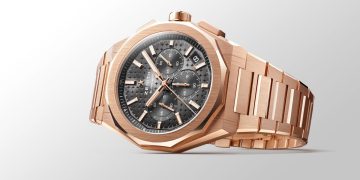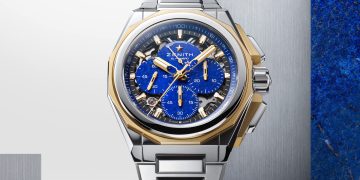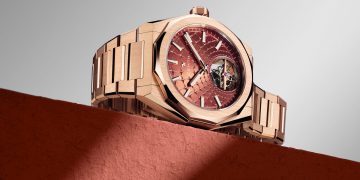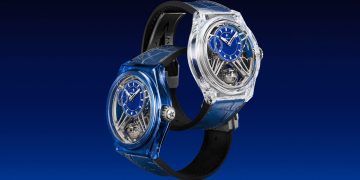Source: Images and content by Vacheron Constantin
http://content.presspage.com/uploads/1999/500_vac-hwm-chrono-ref-inv-11056.jpg?10000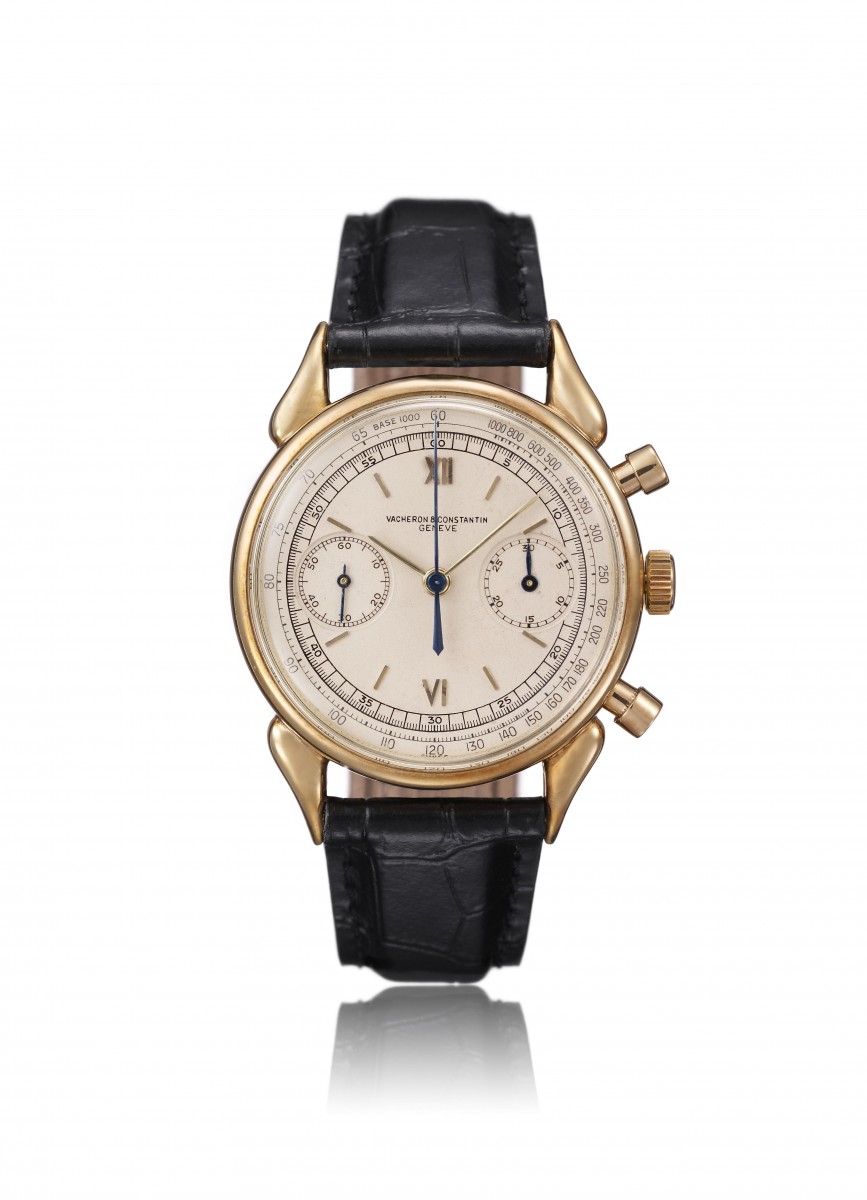
• The chronograph was invented in the early 19th century and subsequently enriched with a split-seconds function, a noble version of short-time measurement.
• Short-time measurement has held a special place for Vacheron Constantin since 1874, when it introduced a hunter-type chronograph watch with a minutes counter
• The Manufacture’s current collections include chronograph and split-seconds movements, sometimes combined with other major complications.
Geneva, September 2021 – Short-time measurement provided by watches’ chronograph function is one of the most demanding horological complications to achieve because of the indispensable precision and reliability of these mechanisms. The chronograph first appeared in the early 19th century as a compteur de tierces, and was subsequently enriched with numerous innovations, notably including the split-seconds function introduced in 1838 and serving to calculate intermediate (split) times. Vacheron Constantin played a strong part in this development and its first known chronograph appeared in 1874. Since then, the Maison has distinguished itself as much by its chronographs as by its Grand Complication watches incorporating this function that is closely bound up with the pioneering spirit of watchmaking.
The chronograph function encapsulates the very essence of Haute Horlogerie. Since the function of these watches is to measure short time periods, they require impeccable precision, unfailing reliability and resistance in often hostile environments. These are all qualities that chronographs have progressively acquired and improved upon, becoming the indispensable characteristics of the instrument-watches that Vacheron Constantin has made its speciality.
On a technical level, chronographs require considerable mastery in terms of energy management as well as in the configuration of a mechanism that must be as smooth in its progress as it is rigorous in its operation. Decisive iterations were progressively introduced as the calculation of time became a crucial, even vital component within the context of sporting feats and scientific discoveries.
The chronograph, an early 19th century invention
The birth and evolution of time measurement cannot be properly understood without the astronomical studies that preceded it. The same is true of the chronograph, one of the most recent horological inventions. It was the Parisian scientist Louis Moinet who invented the compteur de tierces in 1816. This instrument, developed for astronomical observations, was rediscovered at an auction in 2013 and is now considered the first chronograph in history. Beating at the rate of 216,000 vibrations per hour (30 Hz), this pocket stopwatch displays 1/60ths of a second by means of a central hand, seconds and minutes on two separate dials and hours on a 24-hour dial. In 1821, the work of the Frenchman Nicolas Rieussec, watchmaker by appointment to King Louis XVIII, resulted in a device capable of measuring finishing race times at equestrian events. Accurate to 1/5th of a second, it placed a drop of ink – at the beginning and end of the measurement – on a rotating enamel dial housed in a wooden case. Since then, constant progress and innovations have been made in the field of the chronograph, in terms of both miniaturisation and chronometry. As early as 1822, it became a pocket stopwatch and, by the middle of the century, was endowed with three functions: start, stop and zero-resetting.
The split-seconds chronograph for measuring intermediate times was invented in 1831, when the Austrian Joseph-Thaddeus Winnerl presented the first system with a single split-seconds hand that could be stopped before instantly catching up with elapsed time when restarted. This mechanism was improved in 1838 with the introduction of an additional hand. It was not until the 1910s that the first wrist chronographs appeared. Like pocket watches, they were initially equipped with a single pusher for the three functions, generally embedded in the crown. A second pusher for zero-resetting became increasingly common from 1934 onwards. At about the same time, the first split-seconds mechanisms were offered to a clientele increasingly interested in adventure, speed and sports competitions. Meanwhile, research on high frequencies continued, progressively enabling mechanical chronographs to measure times to the nearest 10th, 100th, and even 1000th of a second, making this an essential complication in the watchmaking world.
A complex mechanism
The invention of the chronograph owes much to technical developments preceding its creation, starting with the deadbeat seconds mechanism perfected in the 1750s and highlighted in this pocket watch with independent deadbeat seconds and quarter repeater, the very first of its kind preserved by the Maison and dating from 1819. This first interpretation of a watch equipped with a mechanism enabling the seconds hand to be stopped and restarted without interfering with the time indications prefigured future achievements within a Manufacture that was to forge a reputation for producing chronographs that were as reliable as they were accurate.
On a mechanical watch, the number of jumps made by the seconds hand to complete a full rotation in one minute depends on the oscillation speed of its balance-spring. Thus, on a timepiece beating at 18,000 vibrations per hour, the seconds hand advances at a rate of five “steps” per second. Obtaining one jump per second so as to be able to count them accurately implied storing these impulses by means of a mechanism that releases this force all at once and named “deadbeat seconds”. By rendering it independent thanks to an additional gear train, watchmakers developed what is considered the ancestor of the chronograph, since it was now possible to stop and restart the seconds hand without affecting the running of the hours and minutes hands. The appearance of a dedicated seconds hand, minutes and even hours counters, followed by one and then two pushers on wristwatches, gave the chronograph the appearance we now know today.
From a technical standpoint, chronograph mechanisms can be built in two ways. The first, nobler yet more complex option consists of integrating this function into the design of the watch calibre itself, while the second involves adding a module or plate to an existing base movement. Although these architectures vary in terms of construction, the operating principle remains the same. A system of pushers activating a control wheel manages a clutch that engages and disengages the chronograph with or from the gear train. The clutch can be either horizontal or vertical. The control system is generally of two kinds: a cam in the most common constructions or a column wheel for the more sophisticated mechanisms. Zero-resetting is achieved by hammers acting on the axes of the chronograph hands.
Split-seconds chronographs are distinguished by two central seconds hands. At the start of the measurement, they move in perfect synchronisation until a first press on the split-seconds pusher stops the eponymous hand in order to calculate a split time. A second press gives this additional hand the impetus required to catch up with the first which has continued running. The operation can be repeated as many times as necessary, while stopping the split-seconds hand and then the first hand will give two definitive times. Mechanically, this function is a far more complex watchmaking complication than a simple chronograph. With the split-seconds hand, it is indeed equipped with a second disengagement system equipped with clamps to bring into contact or to separate the chronograph wheel and pinion from the split-seconds wheel and pinion. The split-seconds hand is repositioned by means of a spring wound by the chronograph.
Two centuries of chronographs at Vacheron Constantin
Vacheron Constantin has been fully involved in these developments since its origins in 1755. As a watchmaker renowned for the quality of its short-time measurements, it has made its timepieces creations that are known for their impeccable functionality and their complicated movements. Among them, short-time measurement has occupied a special place since the very first developments in this field, while consistently displaying Vacheron Constantin’s characteristic elegance, as shown by this 1874 hunter-type watch, the oldest chronograph with minutes counter in its collections.
At the turn of the century, Vacheron Constantin began converting its models into wristwatches. The oldest known wrist chronograph in its production, a single-pusher gold model with a minutes counter, dates from 1917. From then on, the Maison maintained an undiminished reputation in the field of timekeeping with the advent of “miniature” timepieces, whose practicality and functionality paved the way for the instrument watches of the first half of the 20th century. Vacheron Constantin kept step with this trend through its single-pusher chronographs of the 1930s and 1940s, prized for their reliability in robust stamped steel cases that were still in production in the 1970s. Stylistic research nevertheless remained an important preoccupation for the Manufacture, which presented its first water-resistant and antimagnetic chronograph, named Cornes de Vache, in 1955.
In technical terms, Vacheron Constantin’s reputation among collectors was already well established. Its Calibres 1141 and 1142 are among the essential hand-wound chronograph movements. This same 1141 movement with column wheel and lateral clutch has also equipped the chronographs in the company’s Malte, Patrimony and Traditionnelle collections and continues to drive a perpetual calendar version in the Traditionnelle collection. In 2015, Vacheron Constantin presented the Overseas chronograph equipped with the Hallmark of Geneva-certified self-winding in-house Calibre 5200 Manufacture movement, the result of five years of research and development. This chronograph returned in 2021 in a 150-piece limited edition: the Overseas Everest Chronograph is available with a titanium case housing NAC-treated Calibre 5200 featuring an Everest-engraved oscillating weight.
Split-seconds chronograph
A key player in the field of chronographs, Vacheron Constantin is also active in the realm of split-seconds mechanisms. Witness an 1889 order placed for a split-seconds chronograph, which was sent to Buenos Aires at the request of a horse racing enthusiast who had expressly asked that the back of the oxidised silver case be adorned with an enamelled jockey. At the time, the Vacheron Constantin name was already widely known beyond Switzerland’s borders, and associated with products embodying great expertise and exemplary finishing. In the United States in particular, John Magnin, the company’s official representative in North America, opened an establishment in 1831. From then on, the Manufacture’s mechanisms conquered the hearts of Americans, including artists, financiers and others. In 1904, industrialist John Davison Rockefeller acquired three Vacheron Constantin complicated pocket watches, all equipped with a chronograph: two of them had a gold split-seconds mechanism and one also featured a minute repeater.
This expertise in complicated and ultra-complicated watches is such that, since the beginning of the last century, the Manufacture has repeatedly been asked to produce exceptional models. Within this context, it is important to recall that Grand Complication models must incorporate a mechanism for calculating short times, especially in its noble split-seconds chronograph version. Such was notably the case of the timepiece presented to His Majesty Fouad 1 in 1929 by the Swiss expatriate community in Egypt, embodying a major technical feat. The same is true of the one crafted 17 years later by Vacheron Constantin for his son King Farouk, combining 14 complications including a split-seconds chronograph.
The Reference 57260 watch, created for the 260th anniversary of the Maison in 2015, is the ultimate achievement of this approach. Its 57 complications include a split-seconds chronograph with a double retrograde display, a visually fascinating watch industry first featuring two second hands sweeping over separate counters.
Vacheron Constantin’s expertise in complication watches is not limited to the creation of one-of-a-kind models. The integration of split-seconds chronograph movements, a highly sophisticated mechanism, can also be seen in the Manufacture’s current collections. Such is notably the case with Calibre 3500, a technical masterpiece which for the first time powered a model in the Harmony collection launched in 2015 to mark the 260th anniversary of the Maison. The same Calibre 3500 is to be found in the Traditionnelle ultra-thin split-seconds chronograph presented in 2021. Its special design with a peripheral oscillating weight mounted on ball bearings makes this ultra-thin selfwinding movement one of the thinnest for this type of complication (5.20 mm), enabling an overall watch thickness of just 10.72 mm. Designed in the grand watchmaking tradition with its clamps and two column wheels, this movement has nonetheless been endowed with the latest technical developments of the Manufacture, notably ensuring smooth chronograph activation and short-time readings via a dragging minutes hand. The world of watchmaking according to Vacheron Constantin is one that thrives on research and innovation.
This expertise is also illustrated by Les Cabinotiers Grande complication split-seconds chronograph – Tempo presented in 2020, which combines the split-seconds chronograph with other grand complications such as a perpetual calendar, several astronomical functions, a tourbillon and a minute repeater. The most complicated doubled-sided wristwatch ever made by Vacheron Constantin, it is a true mechanical tour de force orchestrated by a remarkable movement with 24 complications and 1,163 components.
Born in 1875, Richard Horacio Edgar Freeman was a leading light of the Grande Époque, a brilliant jack-of-all-trades who always knew how to exercise his charm in order to bounce back. By turns journalist, reporter, writer, scriptwriter and director, he is probably one of the most prolific Anglo-Saxon authors, with more than 170 works to his credit, written in less than 30 years under the pseudonym Edgar Wallace. He ended his career in Hollywood, where he became famous for his film adaptation of Conan Doyle’s The Hound of the Baskervilles and for his participation in the screenplay for King Kong. In residence during the winter of 1922 at the Hôtel Caux-Palace on the heights of Montreux in Switzerland, Edgar Wallace was presented by the manager with a series of Vacheron Constantin watches. As a true connoisseur, he chose a polished 18K gold bassine-type model, a split-seconds chronograph.
Selected watches
1. Rose gold pocket watch with quarter repeater and independent deadbeat seconds (Ref. Inv. 12085) –1819
From the beginning of the 19th century onwards, the Manufacture began developing its first pocket watches equipped with an independent deadbeat seconds hand, like this 1819 model which also has a quarter repeater. Signed Vacheron Chossat & Co on its enamel dial, this timepiece is equipped with a mechanism allowing the central seconds hand to be stopped and restarted without interfering with the flow of the minutes and hours displayed by serpentine hands. This type of timepiece is considered the ancestor of the chronograph.
2. Two-tone silver and rose gold split-seconds chronograph pocket watch (Ref. Inv. 11092) –1889
Les chronographes de poche monopoussoirs simple ou à totalisateur 30 minutes, les plus sophistiqués avec rattrapante, évaluent le cinquième ou le dixième de seconde, parfois le centième pour répondre aux attentes des éleveurs de chevaux et de certains industriels. Au 19e siècle, un client argentin amateur de sport hippique passe commande de ce chronographe à rattrapante avec petite seconde dont le fond personnalisé arbore un jockey en émail. Il s’agit du plus ancien modèle bicolore de la collection privée de Vacheron Constantin.
3. 18K yellow gold chronometer, split-seconds pocket chronograph (Ref. Inv. 11528) – 1913
Progress in astronomy and medicine, as well as the evolution of everyday life in parallel with the development of sports and transport accompanied – and in some cases drove – improvements in watchmaking, including the need for precision in time-measuring instruments. Vacheron Constantin responded to this need, notably with this split-seconds chronograph pocket watch complete with 30-minute totalizer and small seconds hand. This chronometer-certified model was awarded Class A rating certificates from the Geneva and Teddington Observatories and won Third Prize at the Geneva Observatory Competition, as indiciated by the engraving on the back of the watch. Produced in 1913, this model was sold to the Maharajah of Patiala in 1921.
4. Harmony split-seconds chronograph in 950 platinum, 260th anniversary edition (Ref. 5400S/000P-B057) – 2016
To celebrate its 260th anniversary, Vacheron Constantin launched a collection called Harmony in 2015. These cushion-shaped models were inspired by one of the company’s first wrist chronographs dating from 1928. The flagship piece of the new range, the Ultra-Thin Grande Complication Calibre 3500 Chronograph, is distinguished by the slenderness of its selfwinding movement, measuring barely 5.20 mm thick and stemming from seven years of research and development. Housed in a 950 platinum case, it drives a split-seconds chronograph with a 60-minute counter, complemented by a small seconds display and endowed with a 51-hour power reserve. Alongside its classic construction, Calibre 3500 is endowed with the latest technical advances from the Manufacture.



